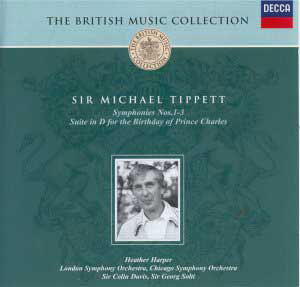This set is of far more than historical significance.
However the choice of works again presents a puzzle. The puzzle here
is what artistic judgement or contractual complication slammed the door
on including the Solti-Chicago version of the Fourth Symphony (yes,
complete with amplified breathing effect). Perhaps someone will enlighten
us. This is not the first time that this sort of thing has happened.
Look at the double Delius set which would have been a natural as a home
for the reissue of the complete orchestral Delius of Mackerras and the
orchestra of Welsh National Opera (originally on the late lamented Argo,
early 1990s). We were treated to some of the Mackerras material
spotted between the Delius double and the single. However other material
edged out of the way a complete Mackerras set.
The First Symphony has the vitally sprung velocity,
coil and recoil of neo-classical Stravinsky but chamfered down with
some of the lyrical bloom of the Concerto for Double String Orchestra.
Snappy pounce and bounce is evident in the Presto in which the
horns sound superb. I note that Sargent conducted its premiere in Liverpool
in November 1945. I doubt that Sargent had a good word for the work.
The start of the Second Symphony yammers and
gauntly barks over a thudding and grunting bass pattern. Rhythmic impetus
is to the fore. The cavernous sluggish dreamscape of the 11 minute adagio
begins with a suggestion of Copland's Quiet City but soon resolves
into density lifted by the superb solo trumpet line (3.33). I wonder
if the presto veloce should go as steadily as it does under Davis.
The stony slam of the piano returns for the finale with its transformational
suggestion of that tricksy opening movement. This brings back many memories
of the original LP which also included the Quartet for four French Horns.
The recording, which comes up insolently defiant of its 35 years age,
was made with the support of the British Council.
The Third Symphony is in two meaty movements
each lasting about half an hour. Decca have tracked these into seven
sections. This is a thoughtful work that does not give up its secrets
willingly. I recall repeatedly listening to a tape of one of the early
BBC broadcasts (Josephine Barstow, BBCNSO/Raymond Leppard, circa 1976).
Unlike the same experience with Rubbra's Eleventh and Havergal Brian's
Twenty-Second, I found my appreciation labouring against an obstinately
obsidian face. I could and still can admire the surface but I still
seek a grip, a toe-hold, on the 'message' of this music. This comes
to some extent in the second movement when Heather Harper sings the
various Blues (words by Tippett). In the Scena and Slow Blues
I the quotation, and then sulphuric transformation, of the furious
gesture (just preceding the cry 'Freude') from Beethoven's Ninth recalls
the Wagnerian and Rossinian quotes in Shostakovich's Fifteenth Symphony.
The recording quality is nothing short of superb. Heather Harper is
one of my favourite singers (alongside Ian Partridge and Gerald English)
but I doubt that she is best suited to this music. Faye Robinson (a
Tippett choice - she appears frequently on Tippett recordings) is reputed
to be more at ease in this work. Robinson appears on the Chandos/Hickox/Bournemouth
set which is also well worth hearing. I liked the steady uprooting power
of the Slow Blues (6) which is like an extruded echo of Roy Harris.
After three tonal but by no means instantly approachable
symphonies we end with a digital recording (the only one in this set)
of the Suite written to celebrate the birth of Prince Charles.
It dates from between the First and Second symphonies. Its five movements
allude to and quote various traditional tunes, folksy-olde-worlde in
character, not soft-centred, and bustlingly raucous in triumph. This
represents a strain of composition that I associate with Vaughan Williams'
Three Portraits from 'The England of Elizabeth' (Previn on RCA-BMG)
and the Rubbra Improvisations on themes by Giles Farnaby (early
Hickox recording again on RCA-BMG). The precision and delicate strength
of the Chicago orchestra is a joy to hear as in the Procession.
Raymond McGill's notes remind us that Tippett used a theme from his
unpublished ballad opera Robin Hood (1934). I wonder if
that score exists. Surely it is time we heard it.
The notes are by Raymond McGill who has slipped into
the shoes of Kenneth Chalmers (who did the required service for the
earlier salvoes in this series). The full sung texts are printed in
the booklet.
This set is valuable for restoring the first recordings
of these busy but not always emotionally yielding symphonies.
Rob Barnett


